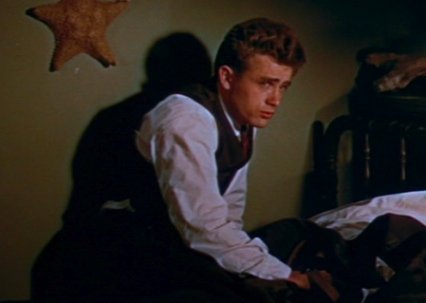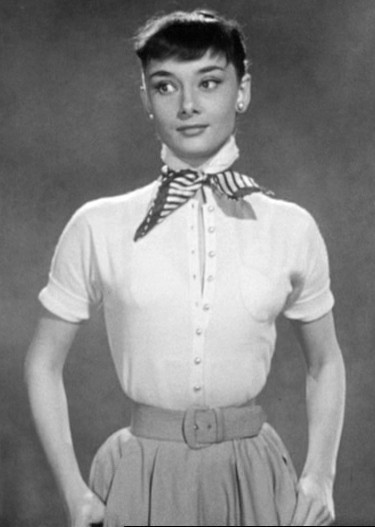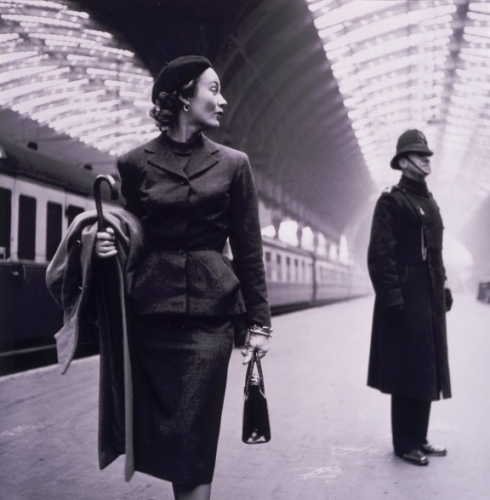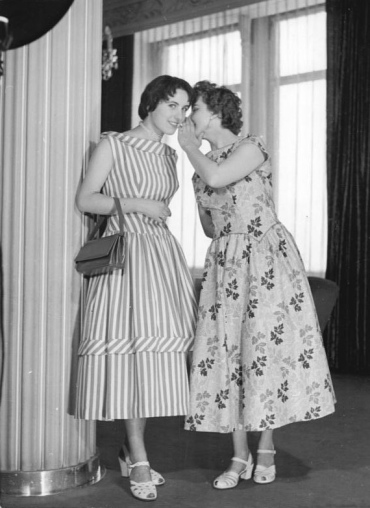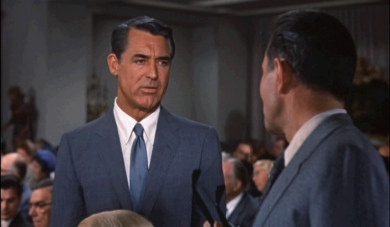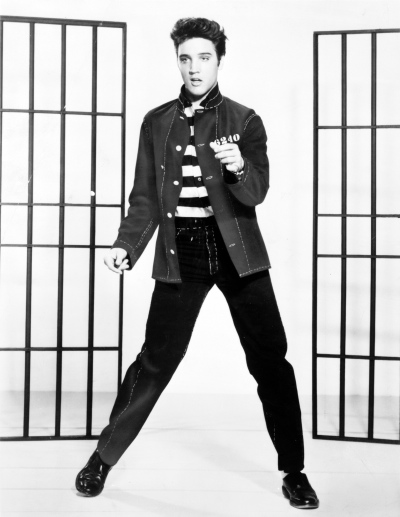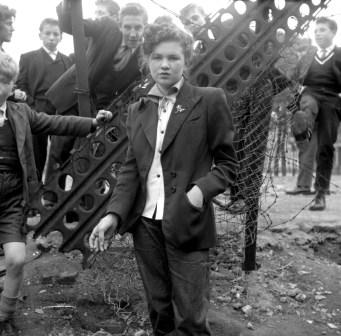|
1950s Fashion1950s fashion, like all fashion, reflected the fears and aspirations of its time. Two decades of deprivation and struggle were relieved by the threat of global nuclear war. Wartime restrictions and rations were removed, disappearing for most by the mid-1950s; in America, and parts of Europe, a new prosperity blossomed out of the ashes.
After the nightmare of the depression and two world wars, many people preferred the safety of conformism. Looking, and acting, like everyone else felt secure. New advances in technology, including the credit card system, made mass-produced clothing the popular choice in westernized countries. The boom in prosperity, and the emptiness many felt in this new world, made conspicuous consumption a must. "Youth culture" first emerged in the late 1940s, gaining ground through the 1950s. Before World War II, children were children until they turned about 18, at which point they became young adults. It was in the 1950s that the "teenager" began adopting fashions of her own design, mirroring her peers instead of her elders.
America and the Soviet Union emerged from World War II as the two world superpowers. American movies, fashions, and consumer products were exported across the world. While many nations resented America's influence, they had little power to stop it. In the USSR, clothes were used by the government as weapons of ideological control. Conservative clothing was supposed to set the "correct" attitudes among students, workers and all citizens. The same designs were used, almost unchanged, from the 1940s until the state's collapse in 1989. Jeans, that ultimate symbol of "bourgeois decadence," were outlawed. This strictness led to the rise of a D.I.Y. aesthetic, with handmade and altered clothes becoming popular, and a sewing machine becoming a prized possession. 1950s Women's Fashion
After World War II, there was a huge push to get women back into the home and the kitchen, to do the traditionally womanly duties of raising children and looking after the house. In magazines, television programs, books and other media, the housewife, or "homemaker," was lauded as the supreme goal; going against one's "femininity" (i.e., being interested in politics or non-wifely duties) was a neurotic fixation. 1950s fashion was an integral part of this push. Unlike the boxy silhouettes of rationed 1940s uniforms, 1950s fashions emphasized fragile femininity, in the form of soft shoulders, stiletto heels, wrist-length gloves and full, billowing skirts. Even working women's outfits hinted at fragility, with pencil-slim skirts and little hats with veil and feathers.
The "New Look" for 1950s women actually originated in the 1940s, with Christian Dior's seminal collection called Corolle. This collection contrasted the austere, "make do and mend" aesthetic of 1940s fashion with full skirts, soft shoulders, and a tight waist, emphasizing the bust and the hourglass-shaped figure. Dior would go on to invent more haute couture 1950s fashions, with names like the Princess Line, the Profile Line, the A Line, and the H Line. His influence remained high throughout the 1950s. Other fashion houses were forced to follow his innovations.
However, this ideal female figure was not possible in nature. Corsets, and "corselettes" (a corset/bra combination) made a comeback at the same time that conical brassieres became popular. Corsets were given names like "Romance" and "Pink Champagne." Advertisements described them as "comfortable," even "revolutionary." 1950s Men's Fashion
Conservative business suits were favored by men, so much so that the "Man in the Gray Flannel Suit" became a known archetype, as well as the title of a 1955 novel Men's 1950s fashion was clean cut and conservative. The "gray flannel suit" referred to a style popular among American men, which started out in the Ivy League colleges. The "American suit" was usually charcoal gray, single-breasted with two or three widely spaced buttons, unwaisted, with no back vent. Also popular was the "penny loafer," a slip-on shoe with a cut-out apron that could fit a penny. Hats became less and less popular among both men and women, throughout the 1950s. By the end of the 1950s they were still seen, though not required for a business uniform; by 1970, they had vanished almost entirely. Men's hair was kept short and neat, typically in a crewcut. A D.A. (short for "Duck's Ass") haircut was seen as a blatant rebellion against the social order. Young people, unsurprisingly, saw this as cool. The Teenager
Dostoyevski wrote in the early 1880's that "Young Russia is talking of nothing but the eternal questions now." With appropriate changes, something very like this is beginning to happen in America, in an American way; a re-evaluation of which the exploits and attitudes of this generation are only symptoms. The first youth cultures started to emerge from conformist 1950s Britain and America. For the first time, young people stopped imitating their elders, inventing new styles of music, dress and expression by themselves. Any diversion from conformist 1950s fashion was frowned upon. Unsurprisingly, many youngsters were seen as ruffians or hell-raisers for violating the unwritten code. As rock and roll music gained popularity, despite (or because of) its sexual undertones, performers like Little Richard, Chuck Berry and Buddy Holly captured the imagination of young people. This was a new sound, distinct from what came before, while still maintaining influences from country, blues, jazz and traditional American music. At this time, rock and roll was seen as dangerous and subversive. Famously, Elvis only appeared on the Ed Sullivan from the waist up, because his "hip gyrations" were considered too lewd. Films like The Wild One and Rebel Without A Cause captured the public imagination. Partly due to these movies, partly due to bad press, a leather jacket and a D.A. haircut became sartorial shorthand for rebellion and violence. In Britain, "Teddy Boys," young men (and women) who dressed up in neo-Edwardian fashions, were seen as dangerous.
At this time, teenage subcultures did not espouse particular philosophies or emotions. Teddy Boys, and Rockers, liked looking good as well as different; the "rebels" did not yet have causes, in the way punks or hippies would. Individual convictions and tendencies still varied from person to person. It was only with the rise of the civil rights movement, and artistic movements like punk and no wave, that politics and style became more firmly wedded together. The Beat Generation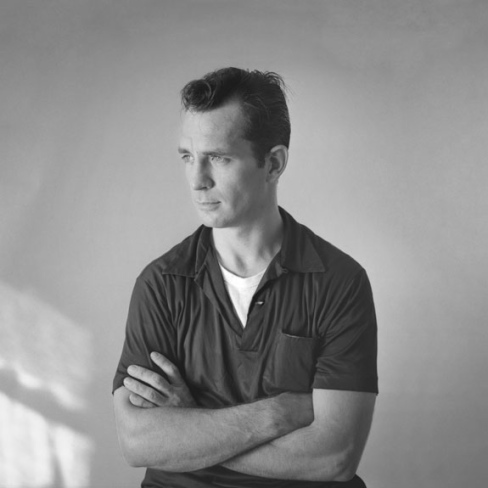
The word "beat" was coined by Jack Kerouac in 1948, then 26 years old, to describe a generation of crazy, illuminated hipsters suddenly rising and roaming America, serious, bumming and hitchhiking everywhere, ragged, beatific, beautiful in an ugly graceful new way...The word meant "beaten down," "downtrodden," or "exhausted." To Kerouac, it also had a spiritual significance, as shorthand for "beatitude." This significance was lost on most people. The press tried to turn this movement into a parody of itself, when not crowing about its immorality. The beats bucked 1950s conventions––and 1950s fashions––as well. Jack Kerouac famously appeared on a forum in black jeans, ankle boots and a checkered shirt––the only panelist to do so. However, the beat philosophy had little to do with dress; its proponents emphasized a somewhat inchoate philosophy which included bumming, hitchhiking and illicit drug use––abhorrent concepts to most 1950s Americans (or westerners in general). Works like Howl Herb Caen coined the word "beatnik" in 1958, shortly after the Russian sputnik satellite was launched. Madison Avenue commercialized and re-sold this idea to the American public as a "bohemian trend" of black turtlenecks, bongo drums, sunglasses and berets. Related Reading:  Jack Kerouac photo by Tom Palumbo, circa 1956. Return to Enjoy Your Style's vintage fashion page. Return from 1950s fashion to Enjoy Your Style's home page. Not what you're looking for? Find it, below: |





